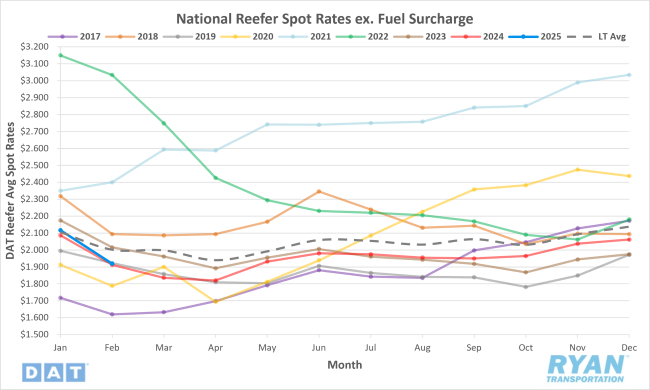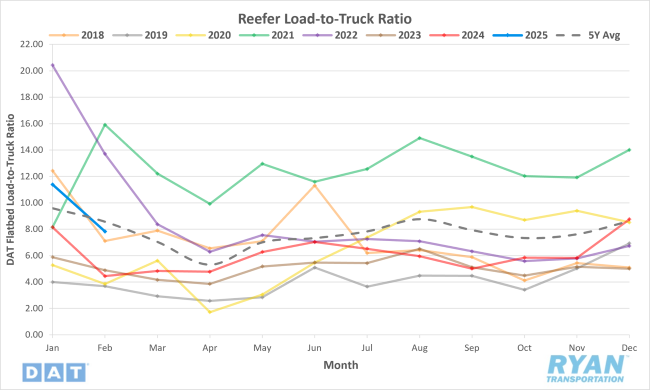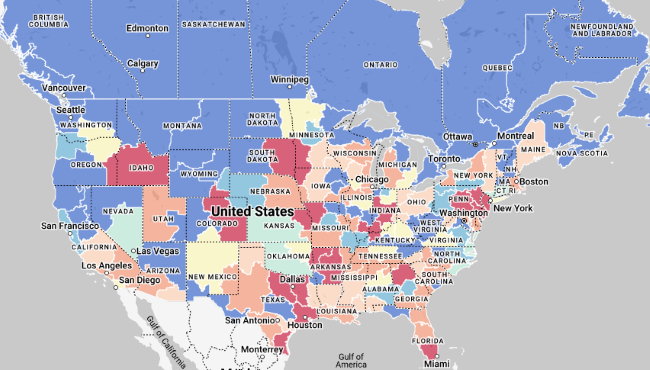Back to March 2025 Industry Update
March 2025 Industry Update: Reefer
A shift away from freeze protect services as temperatures warm up led to softer demand and lower rates across the reefer sector.
Spot Rates

Key Points
- The national average reefer spot rate excluding fuel declined 9.3% MoM, or just under $0.20, in February to $1.92.
- On an annual basis, average reefer spot linehaul rates were up 0.4% YoY compared to February 2024, but were 5.3% lower than the LT average.
- Initially reported average reefer contract linehaul rates were virtually flat MoM in February, registering just 0.1% higher compared to January, but were 1.8% below February 2024 levels.
Load-to-Truck Ratio

Key Points
- The reefer LTR registered a 31.2% MoM decline in February to 7.83.
- Compared to February 2024, the reefer LTR was up 76.0% YoY but 8.6% below the 5-year average.
- Both refrigerated load and truck posts were down in February, dropping by 38% and 10% respectively, according to data sourced from DAT.
Market Conditions

Reefer Summary
Mexico is one of the world’s largest exporters of fresh produce, and its agricultural production is distributed across several regions. Key areas include Sinaloa, a leading producer of vegetables like tomatoes, bell peppers, cucumbers and beans on Mexico’s west coast. Just north of Sinaloa is Baja California, a producer of lettuce, strawberries, tomatoes and other leafy greens, exported to the U.S. Toward the country’s east and gulf coast, Chiapas and Oaxaca are known for tropical produce, including bananas, coffee, cacao and papayas. In contrast, the Yucatán Peninsula produces citrus fruits, habanero peppers and tropical fruits like guava and soursop. Mexican avocado production is primarily concentrated in Michoacán. The efficiency of the supply chain is also noteworthy, with avocados being harvested, packed, shipped and reaching consumer tables within a week, as reported by the Association of Avocado Exporting Producers and Packers of Mexico. Businesses relying on cross-border trade should work to adjust procurement strategies and prepare for potential increases with the on-again, off-again tariffs placed on Mexico.
Each spring, the Florida Strawberry Festival rolls out the red carpet to welcome visitors from throughout the Sunshine State and the world. This year, the event runs from February 27 to March 9 in Plant City, often known as the “Winter Strawberry Capital of the World.” Florida produces approximately 15% of the U.S.’s strawberries, making it the second-largest strawberry-producing state after California. It generates hundreds of millions of dollars annually and provides significant employment opportunities, especially during the harvest season. Florida strawberries are a winter crop, with peak production occurring from November through March, making them a vital source of fresh strawberries during a time when other U.S. regions cannot grow them. Annually, Florida produces about 215.73 million pounds of strawberries, or the equivalent of just over 5,000 refrigerated truckloads in the eight weeks from the start of February to the end of March. That’s around 650 loads of strawberries shipped each week, marking the start of the Florida produce season, which typically sees available reefer capacity tighten considerably from early April to the latter part of May when the season peaks.
John Walt Boatright, Director of Government Affairs for the American Farm Bureau, said immigrants play an important role in the food supply chain. “Agriculture, and our economy, rely on foreign workers to put food on the table,” Boatright said in an email to FreightWaves. “It’s widely accepted that the immigration system must be fixed, but solutions should ensure vital industries like farming, processing, distribution and food services are not harmed by unintended consequences. These are solutions that Congress must address, not just a presidential administration.” Migrant workers are important to Florida’s agriculture industry,” said Thomas Kennedy, a spokesman for the Florida Immigrant Coalition. “There’s a ton of undocumented, unauthorized labor in the state and in the agriculture sector,” Kennedy told FreightWaves in an interview. “Some of the workers are here on work visas, but a lot of them are undocumented. It’s estimated that 37% to 47% of the state’s agricultural workforce are noncitizens, so it’s a huge population.”